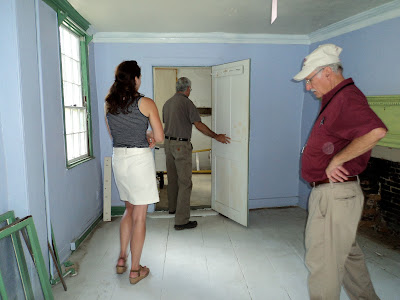Hello, visitors! Welcome to the Strawbery Banke Museum
Historic Preservation blog! The summer of 2012 is in full swing and we hope you consider a visit to the museum in the coming months to witness all the
wonderful opportunities and events that
Strawbery Banke has to offer.
As a nationally registered historic site and museum, one of
Strawbery Banke’s goals is to preserve the historic integrity of the 35
buildings located on the ten-acre property. Curators, preservationists,
architects and contractors have been hard at work creating and implementing the
exciting plan that will rehabilitate ten underutilized properties on museum grounds
in order to lease them as residential or commercial spaces. This endeavor has been named
The Heritage House Program. And through this rehabilitation program Strawbery Banke has three goals:
--The restoration of the exterior to a specific period in order for them to remain an integral part of the
museum.
--To provide Portsmouth with attractive residential and
office spaces for rent in these historic houses, returning underused space back into use.
--To generate an income stream that will not only help to
maintain the buildings, but contribute to the long-term financial sustainability of
Strawbery Banke.
As of now, the Lowd, Winn, Hough, Shapley-Drisco, Jones, Rueben Shapley and Wheelright Houses have been
completed and rented. These are a mix of residential and commercial units. Among current rehabilitations is an
ambitious project underway to rehabilitate the
Shapley Townhouse and convert the interior to office space.
Future posts will explore the Shapley Townhouse project, as well as ongoing work at the Leonard Cotton Tenant House and the planning process for the Thales G. Yeaton House. This blog will document the
progress made on current projects as well as
the beginning stages of the work being done on new ones.
While it is an
expensive and time-consuming process, it is also one that will add financial stability to Strawbery Banke, and educationally enrich the lives of
visitors and tenants who visit the museum every summer. The museum staff is
very excited to start and finish these projects, as well as document all that
happens in between!
In order to remain historically accurate, the museum will follow the Secretary of the Interior’s standards for the treatment of
historic properties. There are four different types of treatment that can
occur under these standards and they include preservation, rehabilitation,
restoration, and reconstruction. They are defined by the Secretary as follows:
What is Preservation?
"Preservation is
defined as the act or process of applying measures necessary to sustain the
existing form, integrity, and materials of an historic property. Work,
including preliminary measures to protect and stabilize the property, generally
focuses upon the ongoing maintenance and repair of historic materials and
features rather than extensive replacement and new construction. New exterior
additions are not within the scope of this treatment; however, the limited and
sensitive upgrading of mechanical, electrical, and plumbing systems and other
code-required work to make properties functional is appropriate within a
preservation project."
What is Rehabilitation?
“Rehabilitation is defined as the act or process of making possible a
compatible use for a property through repair, alterations, and additions while
preserving those portions or features which convey its historical, cultural, or
architectural values.”
What is Restoration?
"Restoration is
defined as the act or process of accurately depicting the form, features, and
character of a property as it appeared at a particular period of time by means
of the removal of features from other periods in its history and reconstruction
of missing features from the restoration period. The limited and sensitive
upgrading of mechanical, electrical, and plumbing systems and other
code-required work to make properties functional is appropriate within a
restoration project."
What is Reconstruction?
“Reconstruction is defined as the act or process of depicting, by
means of new construction, the form, features, and detailing of a non-surviving
site, landscape, building, structure, or object for the purpose of replicating
its appearance at a specific period of time and in its historic location.”
Here at Strawbery Banke we work to rehabilitate and
preserve historic structures and landscapes. Countless hours of research are
done not only on the physical conditions of the houses, but the family
histories as well. By focusing on more than just the architectural aspects of
preservation, Strawbery Banke creates a learning environment for people of all
ages, and visitors from all over the country. The Heritage House Program opens
up amazing possibilities to locals or people planning to move to the state who
wish to learn more about Portsmouth and its rich history.
 |
| Cotton Tenant House Restoration |
 |
| Grants from LCHIP & 1772 Foundation |
If you would like more information you can visit
theheritagehouses.org or come visit Strawbery Banke and see the process for
yourself! Updates on the Heritage House Program will be posted regularly throughout the process, so please come back and continue reading. We look forward to seeing you at the museum!



































.jpeg)
.jpeg)


